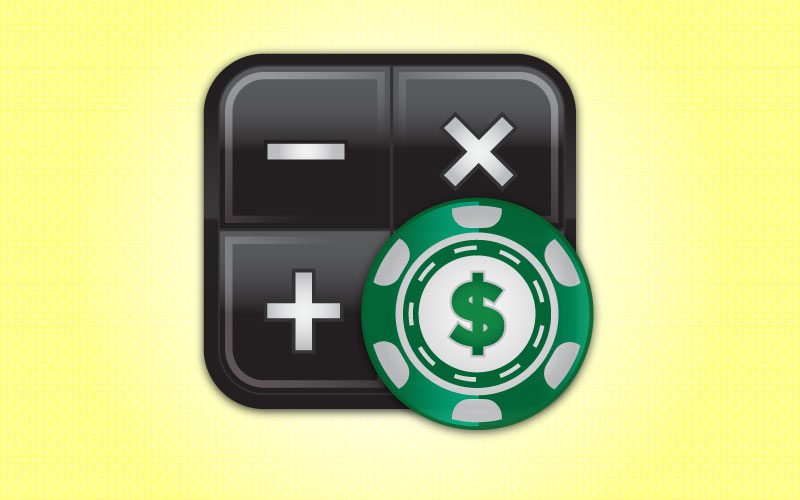A while back, I wrote the EV Calculations Tutorial series to help people to deal with the math side of poker. We followed a very simple process that kept our analysis organized and clean, and we did so only requiring basic addition and multiplication.
While this is probably one of the most important series for players who are looking to learn how to do their own analysis of situations, it didn’t go very deep into different types of applications. What we’re going to do over the next few weeks is bring up some fun applications that we can use to study poker and get better. These applications aren’t necessarily going to be in any particular order, but I’m going to try to cover common questions that I’ve gotten as far as how to use EV calculations to solve certain situations.
Facing a Shove Pre-Flop
It’s a no-limit hold’em cash game with no antes. A middle position player raises to 3bb, and we 3-bet to 10bb. A player in the small blind goes all-in for a total of 42bb including his posted blind, and it folds around to us (we have the SB covered). If we hold JJ, then how tight does our opponent’s shoving range have to be before we cannot profiably call? Here’s the process we’re going to need to solve this:
- Find an EV equation for our call based on our equity when we call.
- Use this EV equation to find the minimal equity we need for calling to be profitable.
- Use an equity calculator to find the range for our opponent that most closely matches this equity requirement found in step 2.
If we call, then there are two possible outcomes. If we lose, then we will lose 32bb on our call, and if we win, then we will profit 56bb. This accounts for the small blind’s entire 42bb stack, the 10bb we re-raised to originally, the 3bb raise from the MP player and the 1bb from the big blind. If we call our equity E and follow the process from the EV Calculations Tutorial series (that I linked to above), then we get the following EV equation:
EV of calling = (E)(56) + (1-E)(-32)
Since we need the EV of calling to be greater than zero for a call to be good, then we need to know the amount of equity that’s needed to satisfy the following inequality:
(E)(56) + (1-E)(-32) > 0
56E – 32 + 32E > 0
88E – 32 > 0
88E > 32
E > 32/88
E > 36.4%
My online equity calculator of choice is ProPokerTools, and it tells us that JJ has 36.2 percent equity when facing {QQ+, AK}. What this tells us is that we can call if we expect that shoving range to be any larger than {QQ+, AK}. For example, if we add AQ, we suddenly have 42.6 percent equity. If we add JJ, then we have 36.6 percent equity.
Shoving Over Someone Pre-Flop
Let’s look at the other side of the situation. Generally speaking, let’s suppose that we raise pre-flop, we face a 3-bet and we have the option to go all-in. We’ll say that this all happens outside of the blinds, the raise pre-flop is to 3bb, the 3-bet is to 10bb, and the shove would be to 42bb. There are three possible outcomes for the EV equation of this shove:
- Villain folds, we profit the pot of 14.5bb
- Villain calls, we win at showdown, and we profit 46.5bb (Villain’s 42bb stack, our 3bb raise and the 1.5bb of blinds)
- Villain calls, we lose at showdown, and we profit -32bb
You’ll notice that we have two variables here. We don’t know how often Villain is going to fold, and we don’t know what our equity is going to be like when we’re called. If we call Villain’s fold percentage F and our equity when called E, then we get the following EV equation for shoving:
EV of shoving = (F)(14.5) + (1-F)(E)(46.5) + (1-F)(1-E)(-32)
If we clean this up a little, then we get a very straight-forward equation:
EV of shoving = 14.5F + (E – EF)(46.5) + (1 – F – E + EF)(-32)
EV of shoving = 14.5F + 46.5E – 46.5EF – 32 + 32F + 32E – 32EF
EV of shoving = -32 + 78.5E + 46.5F – 78.5EF
Since there are two variables, we’ll need to make a chart if we want to analyze this further. A spreadsheet can make this a lot easier. In the following, equity amounts are across the top and fold percentages are down the left-hand side:
| 31% | 32% | 33% | 34% | |
| 30% | -1.57 | -1.02 | -0.47 | +0.08 |
| 32% | -1.11 | -0.57 | -0.04 | +0.50 |
| 34% | -0.65 | -0.13 | +0.39 | +0.91 |
| 36% | -0.19 | +0.31 | +0.82 | +1.32 |
| 38% | +0.27 | +0.76 | +1.24 | +1.73 |
As you can see, this isn’t as straight-forward as a linear scale for this particular situation because both variables affect the equation. However, if you have an estimate for your opponent’s range and which hands he or she will be folding out of that range, then you can get your fold percentage and your equity against the calling range at the same time. You can also do things like figure out how strong the calling range has to be if he’s folding X percent of the time like we did in the example above.
Each of these examples have been dealing with pre-flop scenarios with short stacks, and next week, we’ll get into some other kinds of situations that will hopefully be useful for your study.
Submit your review | |










